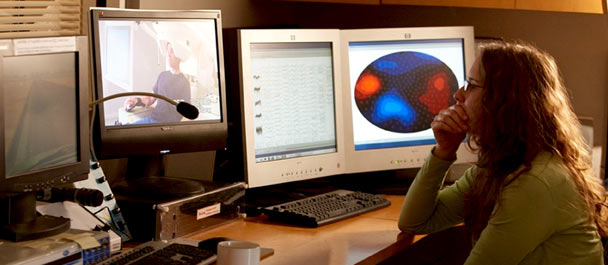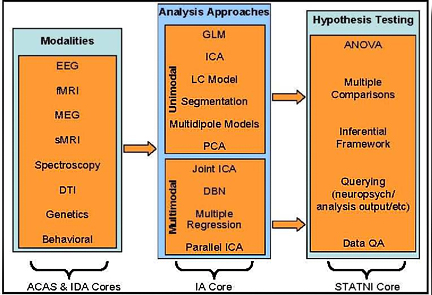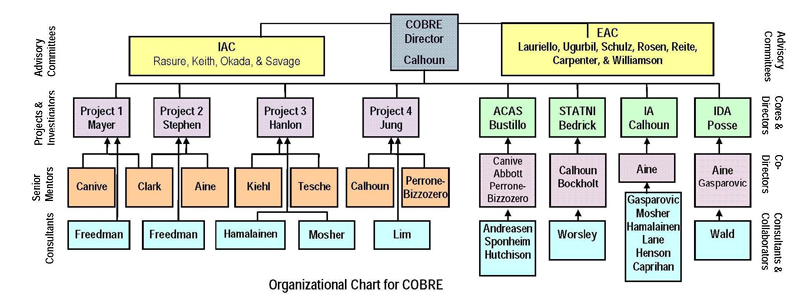
COBRE Phase 1 //

GENERAL DESCRIPTION AND OVERVIEW
This Center for Biomedical Research Excellence (COBRE) will examine the neural mechanisms of schizophrenia. We will do this by integrating multiple neuroimaging methods with psychiatric and neuropsychological, and genetic testing. The unifying theme for our COBRE is the study of schizophrenia as a disorder characterized by abnormalities in structural, functional, and effective connectivity between cortical and subcortical brain regions, producing abnormalities in the integration of information across distributed brain circuits. This Center application submitted by The Mind Research Network (MRN- formerly the MIND Institute) will build on its established record of supporting and enriching basic and clinical biomedical neuroimaging research within the New Mexico (NM) community. Because of our long history in using cutting edge imaging tools (e.g., magnetoencephalography [MEG] and magnetic resonance spectroscopy [MRS], including chemical shift imaging [CSI]), this center will be one of the first in the country to apply these and other imaging tools to the study of schizophrenia in an integrated and comprehensive way. The imaging tools will include methods relevant to the study of neurochemistry and tissue abnormalities (i.e., MRS), in addition to measures of brain anatomy, electromagnetic activity, and functional activity (the BOLD effect in functional magnetic resonance imaging [fMRI]).
 The COBRE will provide support to four outstanding junior investigators through the assistance of strong senior mentors. It will have four Core Units: 1) an Administrative, Clinical Assessment, and Stability (ACAS) Core; 2) a Biostatistics-Neuroinformatics (STATNI) Core; 3) an Image Data Acquisition (IDA) Core, and 4) an Image Analysis (IA) Core. The four projects and four cores will be conducted and located in Pete and Nancy Domenici Hall, home of the Mind Research Network. Dr. Vince Calhoun serves as the Principal Investigator (PI) of this COBRE.
The COBRE will provide support to four outstanding junior investigators through the assistance of strong senior mentors. It will have four Core Units: 1) an Administrative, Clinical Assessment, and Stability (ACAS) Core; 2) a Biostatistics-Neuroinformatics (STATNI) Core; 3) an Image Data Acquisition (IDA) Core, and 4) an Image Analysis (IA) Core. The four projects and four cores will be conducted and located in Pete and Nancy Domenici Hall, home of the Mind Research Network. Dr. Vince Calhoun serves as the Principal Investigator (PI) of this COBRE.
A THEMATIC INTERDISCIPLINARY CENTER
Schizophrenia is a devastating disease that is primarily characterized by disturbances in logical thought processes (e.g., disorganized thinking and paranoia) and sensory perceptions (e.g., hallucinations). However, another hallmark of this disease is cognitive dysfunction, resulting in problems with social and interpersonal interactions (Green et al, a2004). Although current drug regimens are generally successful at controlling the primary symptoms of this disorder, clinicians have had limited success in treating the cognitive impairments. This is the primary focus and unifying theme of this COBRE will be the study of the neural mechanisms that underlie impaired cognition in schizophrenia, as examined by multiple neuroimaging tools. Specifically, we hypothesize that the novel combination of non-invasive neuroimaging techniques will provide an unprecedented view of the neuronal pathologies that underlie the core cognitive dysfunctions of schizophrenia. These span a range of cognitive processes, beginning with a failure of basic inhibitory processes (Project 1), to failure of sensory integration (Project 2), and memory integration (Project 3) to general intellectual decline (Project 4).
Schizophrenia is characterized by general cognitive dysfunction that ranges from basic sensory to higher-order deficits. In a recent NIH sponsored study, a panel of experts agreed that basic sensory processes, attention, memory, concept formation and problem-solving abilities (i.e., intelligence) were among the top cognitive deficits that detrimentally affected patients with schizophrenia (Kern et al., 2004). We conceptualize the 4 individual projects of this COBRE as a hierarchy where each independently investigates these major domains of cognitive dysfunction identified by the expert NIH panel. We begin at a basic level of sensory processing (auditory sensory gating; Project 1), followed by multi-sensory integration (auditory and visual; Project 2), to working memory and relational memory integration (transverse patterning; Project 3) and finally generalized higher cognitive functioning (intelligence; Project 4). Although each of the projects addresses a specific domain of cognitive dysfunction and will carefully probe the basis of these impairments at the different hierarchical levels, these efforts will also result in a dataset which, to our knowledge, is unparalleled in the study of cognitive dysfunction in schizophrenia.
This COBRE will allow us to use our novel data integration techniques, the hierarchical paradigm design, and large sample size to identify “meta-regions” within the brain and common factors associated with overall functional impairment in patients with schizophrenia across several cognitive domains.
 Our goal for integrating the results from these projects is to better understand the interrelatedness of basic sensory and higher cognitive impairments and to identify a few overarching factors that may play into impairments/abnormalities at each of these levels. Project 1 allows us to study impairments in a pure sensory response to a sensory gating paradigm while providing information about connectivity between lower- and higher-order cortical areas such as STG and PFC. Project 2 takes this investigation one step further by studying cortical connectivity in the presence or absence of sensory deficits using a multisensory integration paradigm. This project builds on the results obtained in Project 1 by allowing us to determine what effects possible unisensory deficits have on downstream processing. Project 3 continues the progression by testing relational and working memory function, while clearly requiring sensory input for presentation of the task. Meanwhile, Project 4, in conjunction with the IDA and IA cores acquires and analyzes the structural data (including connectivity) for all three of the functional projects as well as adding spectroscopy to correlate these results directly with intelligence measures. While all four projects will correlate their results, individually, with neuropsychological measures, the integration of the results across all four projects could potentially identify a few factors that cause impairment at all cognitive levels. This COBRE also incorporates an exploratory genomics core that will collect DNA samples of all subjects to obtain information on specific polymorphisms, which can then be correlated to alterations in brain structure and function in patients and in healthy normal volunteers. All 4 projects include exploratory aims to begin to address how a patient’s genetic background impacts measurements of brain function. Ultimately this information could reveal new targets for the treatment of cognitive dysfunction in schizophrenia.
Our goal for integrating the results from these projects is to better understand the interrelatedness of basic sensory and higher cognitive impairments and to identify a few overarching factors that may play into impairments/abnormalities at each of these levels. Project 1 allows us to study impairments in a pure sensory response to a sensory gating paradigm while providing information about connectivity between lower- and higher-order cortical areas such as STG and PFC. Project 2 takes this investigation one step further by studying cortical connectivity in the presence or absence of sensory deficits using a multisensory integration paradigm. This project builds on the results obtained in Project 1 by allowing us to determine what effects possible unisensory deficits have on downstream processing. Project 3 continues the progression by testing relational and working memory function, while clearly requiring sensory input for presentation of the task. Meanwhile, Project 4, in conjunction with the IDA and IA cores acquires and analyzes the structural data (including connectivity) for all three of the functional projects as well as adding spectroscopy to correlate these results directly with intelligence measures. While all four projects will correlate their results, individually, with neuropsychological measures, the integration of the results across all four projects could potentially identify a few factors that cause impairment at all cognitive levels. This COBRE also incorporates an exploratory genomics core that will collect DNA samples of all subjects to obtain information on specific polymorphisms, which can then be correlated to alterations in brain structure and function in patients and in healthy normal volunteers. All 4 projects include exploratory aims to begin to address how a patient’s genetic background impacts measurements of brain function. Ultimately this information could reveal new targets for the treatment of cognitive dysfunction in schizophrenia.


Copyright © 2010 The Mind Research Network.
A 501(c)(3) Non-Profit Organization

